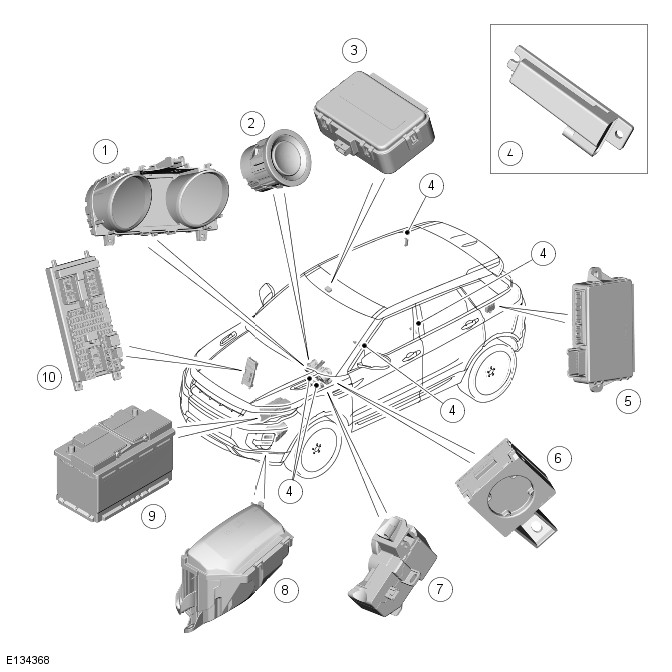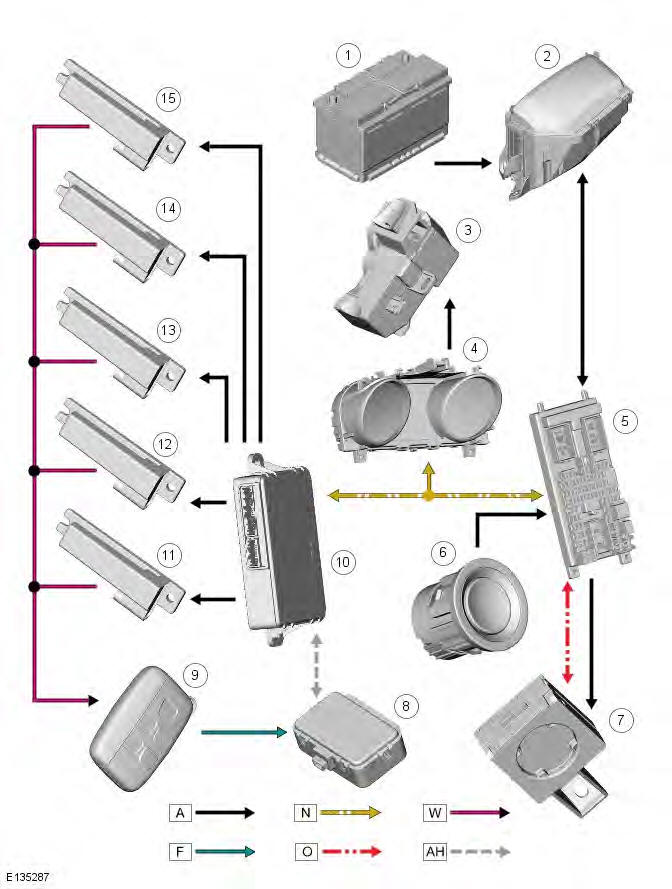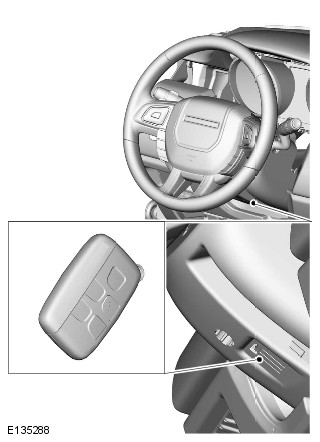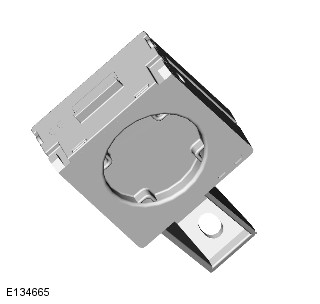Range Rover Evoque: Anti-Theft - Passive
Anti-Theft - Passive - Component Location
COMPONENT LOCATION

- Instrument cluster
- Start/stop button
- Radio Frequency (RF) receiver
- Interior antennas
- Keyless Vehicle Module (KVM)
- Immobilizer Antenna Unit (IAU)
- Electric steering column lock
- BJB (battery junction box)
- Battery
- CJB (central junction box)
Anti-Theft - Passive - Overview
OVERVIEW
Passive Start
The passive start system relies on the detection of a uniquely coded smart key and low frequency antennas strategically situated within the vehicle. The antennas ensure the smart key is always within the active transmission zone of the antennas wherever the smart key is placed inside the vehicle. For this reason the orientation and positioning of the antennas is critical to the correct functioning of the system. The smart key also operates the passive entry system.
Refer to: Handles, Locks, Latches and Entry Systems (501-14 Handles, Locks, Latches and Entry Systems, Description and Operation).
The system provides a secure interface between the CJB (central junction box) and the ECM (engine control module) to prevent unauthorized starting of the engine. This is achieved by immobilization of the engine crank system and the fuel system, using encoded data exchange between the smart key and multiple control modules.
Engine starting is initiated when the encoded data exchange between the smart key and the control modules is verified.
The engine management system will then allow engine crank and fueling when an authorization data message is received from the CJB.
The engine can be started by pressing the start/stop button, and depending on the type of transmission;
- Automatic: when the drive selector is in the 'Park' position and the brake pedal is pressed,
- Manual: when the gear selector is in 'Neutral' and the clutch pedal is pressed.
Anti-Theft - Passive - System Operation and Component Description
Control Diagram
NOTE: A = Hardwired connection; F = RF Transmission; N = Medium speed CAN (controller area network) bus; O = LIN (local interconnect network) bus; W = LF Transmission; AH = Serial Communications Link

- Battery
- BJB (battery junction box)
- Electric steering column lock
- Instrument cluster
- CJB (central junction box)
- Start/Stop button
- Immobilizer Antenna Unit (IAU)
- Radio Frequency (RF) receiver
- Remote handset (smart key)
- Keyless Vehicle Module (KVM)
- Interior antenna
- Interior antenna
- Interior antenna
- Interior antenna
- Interior antenna
System Operation
Passive Start
At the request of the CJB the KVM prompts each of the internal low-frequency antennas to output a signal. When the smart key is in the vehicle cabin, it detects the low-frequency signals and responds with a RF radio frequency data-identification signal back to the KVM via the RF receiver.
If the data received matches that stored in the KVM it continues the passive start process by communicating a 'smart key valid' signal to the CJB via the medium speed CAN bus.
Once the CJB receives the authorization and confirms the response with an internal calculation, it passes coded data to the instrument cluster on the medium speed CAN bus. Upon confirmation from the instrument cluster the ignition is enabled.
Before CJB sends a mobilization signal to the ECM (engine control module), it will exchange encrypted data with the electric steering lock mechanism to authorize unlocking of the steering column. The instrument cluster only provides a ground for the steering lock motor.
The CJB will enable the fuel pump relay which, on diesel vehicles operates the fuel pump and on gasoline vehicles sends a battery voltage supply to the fuel pump driver module to operate the fuel pump in conjunction with the ECM.
If the KVM fails to locate the smart key, a message 'smart key NOT FOUND REFER TO HANDBOOK' will appear in the instrument cluster message center and the keyless start back-up process will have to be used to mobilize and start the vehicle.
To ensure optimum long term reliability of the smart key the battery must be replaced with a brand new, unused battery. If a used battery is installed the "SMART KEY BATTERY LOW" message may not be cleared. To avoid contamination of the contacts the battery should be removed from its packaging and installed into the smart key while wearing gloves. To confirm that the replacement battery is working correctly press the unlock button twice while holding the smart key outside the vehicle, then enter the vehicle with the smart key, press the start button and confirm that the "SMART KEY BATTERY LOW" message is not displayed.
Component Description
Keyless Start Backup
If the vehicle has been unlocked using the emergency key blade or the smart key is not detected by the vehicle, it will be necessary to use the keyless start backup to disarm the alarm and start the engine. The following process must be followed in this event:
- Position the smart key against the underside of the fascia, on the outboard side of the steering column, with the buttons facing downwards. This is the location of the IAU.
- Holding the smart key in position and the brake/clutch pedal depressed, press the start/stop button to start the engine.
Smart key positioned next to immobilizer antenna unit

This process bypasses the data exchange between the KVM and the CJB; this is an inductive process and will operate if the battery in the smart key is discharged. A transponder within the smart key is detected by the IAU. The IAU confirms the code output from the transponder and communicates this code confirmation with the CJB via a LIN bus connection. The CJB then initiates the vehicle start process in the normal manner.
Immobilizer Antenna Unit

The IAU is used if the KVM is unable to authorize the smart key. If the KVM is unable to identify the smart key, for example if the smart key battery voltage is low or there is local RF interference, the transponder within the smart key can be read in the conventional manner. The driver will be alerted to this by a chime and a message in the instrument cluster message center 'smart key NOT FOUND REFER TO HANDBOOK'.
Refer to Keyless Start Backup section of this document.
Low Frequency (Interior) Antennas
Five LF (low frequency) antennas for the passive start system are positioned in specific locations within the vehicle.
The KVM transmits an LF signal via the antennas which is received by the smart key. The smart key then responds by transmitting a RF signal which is received by the RF receiver and passed to the KVM for authorization.
Keyless Vehicle Module
The KVM controls signal transmissions to and from the smart key and provides authorization to allow the vehicle to be started. The module has a medium speed CAN connection to the CJB for authorizing vehicle starting.
Radio Frequency Receiver
The RF receiver transmission is received from the smart key to enable key identification.
Anti-Theft - Passive
Principles of Operation
For a detailed description of the anti-theft - passive system and operation, refer to the relevant Description and Operation section of the workshop manual. REFER to: (419-01B Anti-Theft - Passive)
DTC Index
For a list of Diagnostic Trouble Codes (DTCs) that could be logged on this vehicle, please refer to Section 100-00. REFER to: (100-00 General Information)

